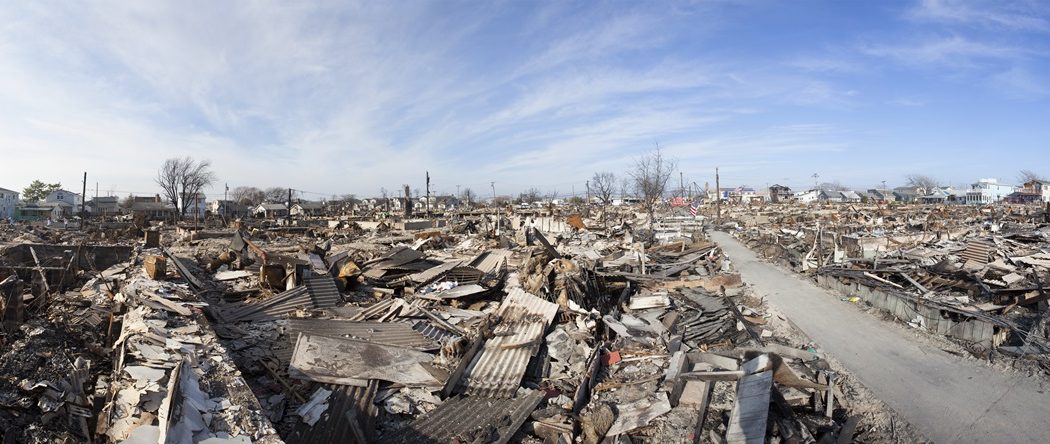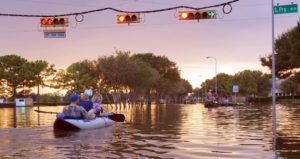In New York City alone, Superstorm Sandy killed 44 people, flooded 17 percent of the city’s land, uprooted trees, collapsed houses, ran ships aground, deluged subway stations, and blew up power lines.
And the impact it has had on the city’s housing may go beyond the $19 billion in property damage it caused; the 2012 storm may have exacerbated gentrification’s potency in some of the neighborhoods hurt by Sandy, according to preliminary research by Earth Institute postdoctoral fellow Allison Bridges.
Two Paths Taken
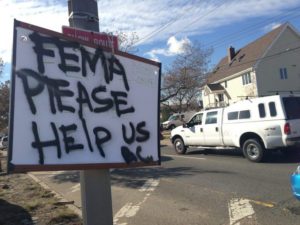
A sign in Broad Channel, Queens, begs FEMA for help after Hurricane Sandy.
Photo: Boss Tweed/Flickr CC
Economically, areas impacted by natural disasters tend toward two extremes, according to separate research by Yung Chun, a former masters student in Columbia University’s Graduate School of Architecture, Planning and Preservation.
The first outcome occurs when investment in real estate is seen as too risky, resulting in disinvestment.
In the aftermath of Sandy, the properties in the Staten Island community of Oakwood Beach sank in value, threatened by repeated flooding. Ultimately, the community’s residents decided not to rebuild, choosing to sell their property and move away.
The other post-disaster outcome, Chun writes, is heavy investment leading to gentrification, or the shift of largely lower-income neighborhoods to the middle-and higher income bracket. In these instances, the natural disaster results in an opportunity to rebuild what is seen as underdeveloped property.
The differences in perceived potential value largely depend on the location’s proximity to a downtown and valued amenities like public transportation. This second outcome is what happened in the Red Hook and Sunset Park neighborhoods in Brooklyn after Sandy. But it’s difficult to tease out how much of this is the result of Sandy versus the continuation of gentrification that was already underway in these neighborhoods.
Potential value and investment are important to the post-disaster recovery process. Unlike public infrastructure, “the market primarily drives the repair, rebuilding or replacement of housings [sic] after natural disasters,” Yung wrote. The heightened value of the area then results in an “imbalance between supply and demand of housing units,” which can disproportionately affect people of color and people with fewer resources.
It’s this “imbalance” that Earth Institute postdoctoral researcher Allison Bridges wants to highlight. “The goal of urban planning should be to guide investment so that it is spatially balanced by using certain incentive programs,” she continued. “This is the larger point of all of my research, post-Sandy or otherwise.”
Evidence for Gentrification
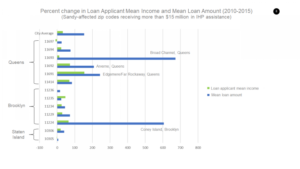
Earth Institute researcher Allison Bridges found evidence of land speculation and gentrification in several neighborhoods hardest hit by Sandy. Sunset Park and Red Hook are not included in this chart, as they were already known to be gentrifying. Image: Allison Bridges
Is post-Sandy New York, like post-Hurricane Katrina New Orleans, another case of developers profiting from a catastrophe in which long-time residents have been displaced? That’s one of the questions Bridges is trying to answer.
For her study, Bridges looked for financial signs of land speculation — or the buying-up of land in hopes that its value will rise — in Queens, Brooklyn, and Staten Island.
She used post-Sandy monetary assistance as a measure of what parts of the city were heavily damaged by the hurricane. Specifically, she looked at money provided by the Federal Emergency Management Agency’s Individuals and Households Program (IHP).
She determined areas receiving more than $15 million in IHP assistance to have been heavily damaged by Sandy. Bridges found signs of land speculation in the heavily damaged areas of Queens’ Broad Channel, Arverne and Edgemere, and Brooklyn’s Coney Island neighborhoods.
In these areas, the average loan amount jumped by almost 300 percent — far above the city-wide average of about 150 percent — between 2010 and 2015. This dramatic increase in loan size implies the occurrence of land speculation, and therefore raises the specter of gentrification.
Bridges hopes to publish these findings in a peer-reviewed journal in the coming months.
It’s Complicated
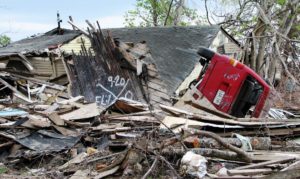
The devastated Third War of New Orleans post-Katrina. Photo credit: Storm Cunningham.
What do the study findings mean for people of color and low-income households?
Although gentrification often evokes images of monied whites pushing out poorer African-American and Latinx people from communities in which they’ve long lived, gentrification doesn’t always lead to displacement.
Even in the gentrifying areas heavily damaged by Sandy, it is difficult to parse out the chaos of so many individual lives and outside forces in a non-experimental setting. Determining whether underprivileged people are being displaced is as difficult as pinpointing climate change as the cause for any particular storm.
What we do know is that Superstorm Sandy struck low-lying areas within flood zones occupied by many older residents, single-parent households or generally low-income earners, Bridges said.
With or without gentrification, household insecurity for low-income renters is high. Latinx and African-American residents in neighborhoods that gentrified in New York City during the 2000s were more susceptible to displacement than those in neighborhoods that were gentrified in the two previous decades, according to a 2018 study. And there was a big spike in people evicted from their rental properties after Sandy, Bridges noted.
“It’s hard to know where people are going,” she added. “That would be the next step.”
Future Implications
Unlike the tropics, whose latitudes power hurricanes with warm air and seawater, the North Atlantic’s waters are typically too cold to sustain strong hurricanes. But a confluence of atypical factors pushed Sandy onto New York City’s shores with winds as fast as 115 miles-per-hour. One of these was the unseasonably warm North Atlantic water, which may be attributable to climate change.
“While Hurricane Sandy as an individual extreme climate event cannot be attributed to climate change, it serves as warning for cities regarding disaster risks, focuses attention on the importance of reducing climate vulnerability, and highlights the need to include increasing climate risks and resilience into rebuilding programs,” according to a 2014 study published in the journal Global Environmental Change.
Superstorm Sandy may be a harbinger of what’s to come. Warming temperatures and higher sea levels resulting from human-caused climate change are expected to increase the number of powerful storms that strike the northeastern U.S.
More powerful storms won’t just lead to more physical damage; they could also worsen existing socio-economic disparities. This is because distributing relief aid equitably among affected areas is challenging, vulnerable populations take longer to recover, and long-term recovery is often driven by economic goals rather than social equity.
As cities and states scramble to build resilience against the physical onslaughts of climate change, Bridges’ study is a reminder that it is also important to prepare for and try to prevent the societal harms that a warming world could bring.
Featured photo (via Adobe Stock) shows the devastation of the fire that destroyed approximately 100 houses during Hurricane Sandy in the flooded neighborhood at Breezy Point in Far Rockaway area of New York City on October 29; 2012.
This article by Clinton Parks originally appeared on the website of the Earth Institute at Columbia University. Reprinted here by permission.

